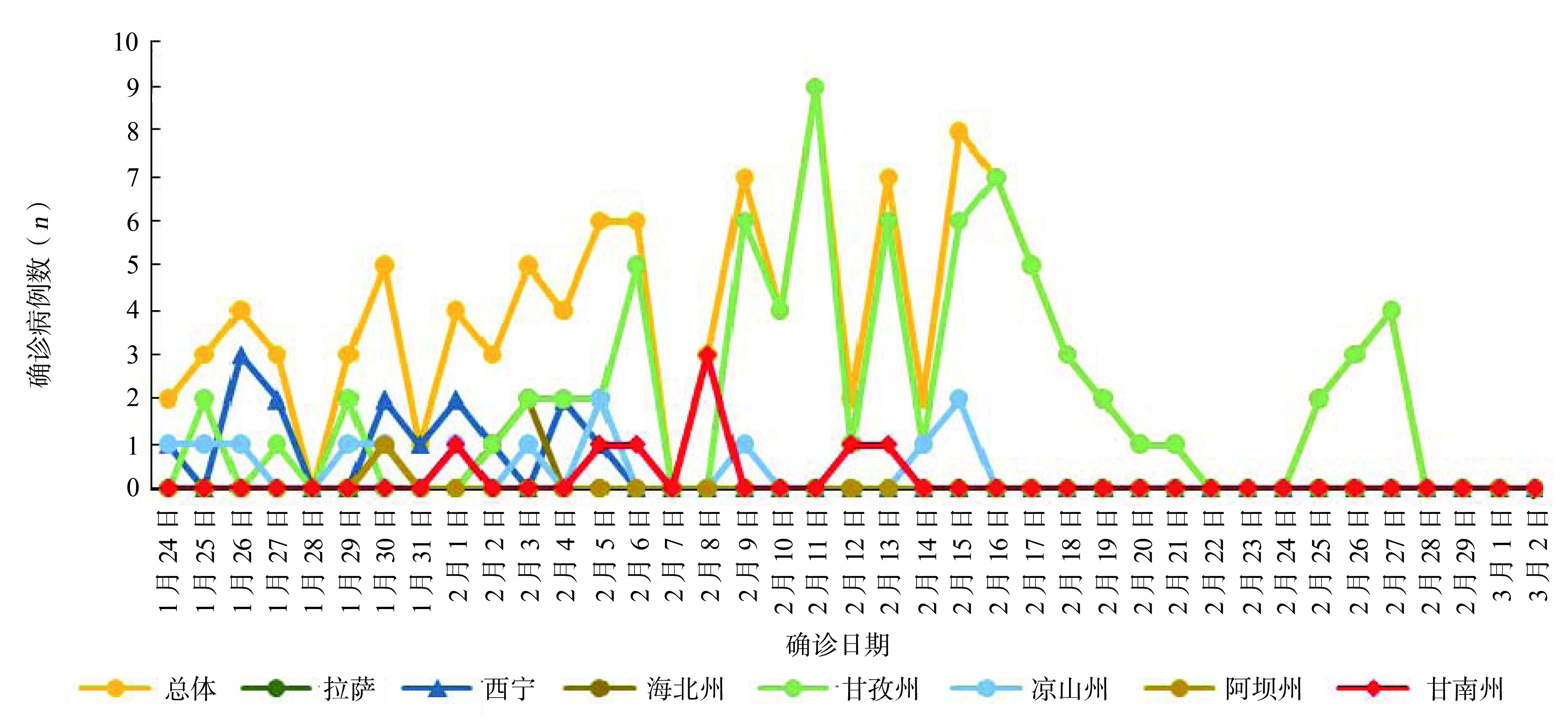Analysis of the epidemic status of coronavirus disease 2019 in high altitude ethnic areas of China and discussion on related influencing factors
-
摘要:
目的 分析中国高海拔民族地区新型冠状病毒肺炎(coronavirus disease 2019, COVID-19)流行现状与相关影响因素, 为制订、实施该地区COVID-19等传染病的防控策略、措施提供参考依据。 方法 采用描述性流行病学方法分析疫情的三间分布, 并基于传染病控制理论分析其面临的挑战。 结果 五省、自治区(西藏、青海、四川、云南、甘肃)高海拔民族地区确诊人数119例, 占五省、自治区全部确诊人数14.5%, 占全国0.1%。甘孜州确诊人数最多为78人, 占四川14.5%, 占高海拔民族地区的65.5%;患者总性别比1:0.8, 平均年龄为(41.7±16.7)岁, 最小发病者年龄为3岁, 最大发病者年龄为77岁。有湖北旅居史患者30人, 占25.2%。与确诊人员有密切接触史69人, 占58.0%。输入性病例30人, 占25.2%, 无死亡病例。 结论 总体病例数量少, 疫情平稳, 个别地区疫情突出; 疫情呈前期增长, 后期下降趋势, 部分地区连续多天无新增; 高海拔民族地区面临传染源管理追踪、预防救治、自然环境不利等影响因素, 因此有必要建立跨区域的COVID-19等传染病联防联控长效机制, 制订高海拔民族地区COVID-19等传染病防控方案, 推动防控机制长期、有效开展。 Abstract:Objective To analyze the epidemic status of coronavirus disease 2019(COVID-19) and related influencing factors in the high altitude ethnic areas of China, so as to provide basis for the formulation and implementation of COVID-19 prevention and control strategies and measures in this areas. Methods The descriptive epidemiological method was used to analyze the three distribution of epidemic situation, and the challenge was analyzed based on the theory of infectious disease control. Results 119 confirmed cases in the high altitude ethnic areas of five provincial-level regions including Tibet, Qinghai, Sichuan, Yunnan, Gansu accounted for 14.5% of all the confirmed cases in five provincial-level regions, and for 0.1% of the whole country. The number of confirmed cases in Ganzi Prefecture was 78 at most, accounting for 14.5% of Sichuan Province and 65.5% of high-altitude ethnic areas. The total sex ratio of the patients was 1:0.8, with an average age of(41.7 ± 16.7) years. The youngest case was 3 years old, and the oldest case was 77 years old. 30 people had a history of living in Hubei, accounting for 25.2%, 69 people had a history of close contact with the diagnosed person, accounting for 58.0%. 30 imported cases accounted for 25.2% and there were no deaths. Conclusions The overall number of cases is small, the epidemic situation is stable, and the epidemic situation in some areas is prominent; the epidemic situation has increased in the early stage and declined in the later stage, and there has been no new increase in some areas for several consecutive days; the high-altitude ethnic minority areas are faced with such influencing factors as management and tracking of infectious sources, prevention and treatment, adverse natural environment, etc. So it is necessary to establish a long-term mechanism of cross regional COVID-19 and other infectious diseases joint prevention and control, and formulate COVID-19 and other infectious diseases in the high-altitude ethnic minority areas disease prevention and control plan, promote the long-term and effective development of the mechanism. -
表 1 高海拔民族地区新冠肺炎确诊情况[n(%)]
Table 1. Coronavirus disease 2019 in high altitude areas [n(%)]
变量 西藏 青海(西宁/海北州) 西宁 海北州 四川(甘孜/凉山州/阿坝州) 甘孜州 凉山州 阿坝州 甘肃(甘南州) 合计 性别 男 1(100.0) 12(66.7) 11(73.3) 1(33.3) 51(55.4) 43(55.1) 8(61.5) 0(0.0) 3(37.5) 67(56.3) 女 0(0.0) 6(33.3) 4(26.7) 2(66.7) 41(44.6) 35(44.9) 5(38.5) 1(100.0) 5(62.5) 52(43.7) 年龄(岁) 34.0 32.2±12.2 34.2±11.8 22.3±11.0 42.8±17.3 43.1±17.6 42.3±16.3 26.0 51.8±8.0 41.7±16.7 湖北旅居史 有 1(100.0) 15(83.3) 12(80.0) 3(100.0) 14(15.2) 5(6.4) 8(61.5) 1(100.0) 0(0.0) 30(25.2) 无 0(0.0) 3(16.7) 3(20.0) 0(0.0) 78(84.8) 73(93.6) 5(38.5) 0(0.0) 8(100.0) 89(74.8) 确诊人员接触史 有 1(100.0) 10(55.6) 7(46.7) 3(100.0) 52(56.5) 39(50.0) 13(100.0) 1(100.0) 7(87.5) 69(58.0) 无 0(0.0) 8(44.4) 8(53.3) 0(0.0) 40(43.5) 39(50.0) 0(0.0) 0(0.0) 1(12.5) 50(42.0) 输入病例 是 1(100.0) 14(77.8) 11(73.3) 3(100.0) 15(16.3) 6(7.7) 8(61.5) 1(100.0) 0(0.0) 30(25.2) 否 0(0.0) 4(22.2) 4(26.7) 0(0.0) 77(83.7) 72(92.3) 5(38.5) 0(0.0) 8(100.0) 89(74.8) 合计 1(0.8) 18(15.1) 15(12.6) 3(2.5) 92(77.3) 78(65.5) 13(10.9) 1(0.8) 8(6.7) 119 表 2 确诊COVID-19病例流向表
Table 2. Flow of confirmed cases in COVID-19
起点 终点 人数 武汉 拉萨 1 武汉 西宁 12 武汉 海北 3 武汉 凉山州 6 宜昌 凉山州 2 厦门 凉山州 1 北京 凉山州 1 武汉 阿坝州 1 武汉 甘孜州 5 雅安 甘孜州 1 成都 甘孜州 2 拉萨 甘孜州 1 合计 36 -
[1] 西藏自治区人民政府.自然地理[EB/OL]. (2020-03-02)[2019-03-03]. http://www.xizang.gov.cn/.People's Government of Tibet Autonomous Region. Physical geography[EB/OL]. (2020-03-02)[2019-03-03]. http://www.xizang.gov.cn/. [2] 田添.青藏高原重点地区棘球蚴病的疾病负担研究[D].北京: 中国疾病预防控制中心, 2018.Tian T. Investigation on disease burden of echinococcosis in high endemicity areas of Qinghai-Tibet Plateau[D]. Beijing: Chinese Center for Disease Control and Prevention, 2018. [3] 吴树峰, 苏倚剑, 马乐, 等.高原传染性疾病对卫生工作的影响及对策[J].西南军医, 2015, 17(1): 10-12.DOI: 10.3969/j.issn.1672-7193.2015.01.004.Wu SF, Su YJ, Ma L, et al. Impact of infectious diseases on high plateau on medical services and the countermeasures[J]. Journal of Military Surgeon in Southwest China, 2015, 17(1): 10-12. DOI: 10.3969/j.issn.1672-7193.2015.01.004. [4] 尚云川.四川藏区艾滋病防治对策研究[J].藏学学刊, 2008, (00): 183-187.Shang YC. Study on AIDS prevention and control strategies in Tibetan areas of Sichuan Province[J]. Journal of Tibetology, 2008, (00): 183-187. [5] 丁香园.新型冠状病毒肺炎疫情实时动态[EB/OL]. (2020-03-02)[2019-03-03]. https://ncov.dxy.cn/ncovh5/view/pneumonia?from=timeline.Ding XY. Novel coronavirus pneumonia epidemic situation real-time dynamic[EB/OL]. (2020-03-02)[2019-03-03]. https://ncov.dxy.cn/ncovh5/view/pneumonia?from=timeline. [6] 国家统计局人口和就业统计司编.中国人口和就业统计年鉴: 2018[M].北京: 中国统计出版社, 2018.Department of Population and Employment Statistics, National Bureau of Statistics. China population and employment statistics yearbook: 2018[M]. Beijing: China Statistics Press, 2018. [7] 刘晓红.基于人本管理的四省藏区社会治理研究[J].民族学刊, 2018, 9(1): 9-18, 98-101.DOI: 10.3969/j.issn.1674-9391.2018.01.002.Liu XH. Research on social governance in the Tibetan areas of four provinces based on humanistic management[J]. Journal of Ethnology, 2018, 9(1): 9-18, 98-101. DOI: 10.3969/j.issn.1674-9391.2018.01.002. [8] 杨明洪.统筹西藏与四省藏区协调发展的战略意义与实践[J].开发研究, 2017, (3): 7-15.DOI: 10.13483/j.cnki.kfyj.2017.03.002.Yang MH. Strategic significance and practice of coordinating the development of Tibet and four provinces[J]. Research on Development, 2017, (3): 7-15. DOI: 10.13483/j.cnki.kfyj.2017.03.002. [9] 万绍平, 郑世凡, 王燕, 等.行政区划有边界艾滋病传播无边界—论不同行政区划相邻地区间的艾滋病防治合作问题[J].卫生软科学, 2006, (6): 595-597.DOI: 10.3969/j.issn.1003-2800.2006.06.035.Wan SP, Zheng SF, Wang Y, et al. Administrative divisions have boundaries and AIDS transmission has no boundaries--On the cooperation of AIDS prevention and treatment between adjacent areas of different administrative divisions[J]. S Sci Health, 2006, (6): 595-597. DOI: 10.3969/j.issn.1003-2800.2006.06.035. [10] 甘孜藏族自治州卫生健康委员会[EB/OL]. (2020-03-02)[2019-03-03]. http://wjw.gzz.gov.cn/.Health and Health Committee of Ganzi Tibetan Autonomous Prefecture[EB/OL]. (2020-03-02)[2019-03-03]. http://wjw.gzz.gov.cn/. [11] 付会文, 赵智东, 郭安, 等.经鼻高流量鼻导管湿化氧疗治疗中老年重症难治性肺炎合并呼吸衰竭的临床观察[J].疑难病杂志, 2019, 18(2): 136-139.DOI: 10.3969/j.issn.1671-6450.2019.02.007.Fu HW, Zhao ZD, Guo A, et al. Clinical observation of nasal high-flow nasal canal humidification oxygen therapy for middle-aged and elderly patients with severe refractory pneumonia complicated with respiratory failure[J]. Chin J Diffict and Compl Cas, 2019, 18(2): 136-139. DOI: 10.3969/j.issn.1671-6450.2019.02.007. [12] 李宏.浅析高原地区高血压病治疗预防策略[J].中西医结合心血管病电子杂志, 2019, 7(6): 13-14.DOI: 10.16282/j.cnki.cn11-9336/r.2019.06.008.Li H. Treatment and prevention strategies of hypertension in high altitude area[J]. Cardiovascular Disease Journal of integrated traditional Chinese and Western Medicine, 2019, 7(6): 13-14. DOI: 10.16282/j.cnki.cn11-9336/r.2019.06.008. [13] 张晓燕.关于高海拔民族地区突发公共事件应急管理的思考[J].青海社会科学, 2012, (3): 128-132.DOI: 10.14154/j.cnki.qss.2012.03.031.Zhang XY. Thinking of the emergency management of public emergencies in high altitude ethnic areas[J]. Qinghai Social Sciences, 2012, (3): 128-132. DOI: 10.14154/j.cnki.qss.2012.03.031. [14] 杜涛.我国31省(市)基层医疗卫生服务效率评价[J].延安大学学报(社会科学版), 2019, 41(5): 88-95. http://www.wanfangdata.com.cn/details/detail.do?_type=perio&id=yadxxb-shkxb201905014Du T. Efficiency evaluation of China's primary healthcare service in 31 provinces[J]. Journal of Yanan University(Social Science Edition), 2019, 41(5): 88-95. http://www.wanfangdata.com.cn/details/detail.do?_type=perio&id=yadxxb-shkxb201905014 [15] 张朝霞, 史绍蓉, 安顺英, 等.青海基层医疗机构卫生人员调查分析[J].基层医学论坛, 2015, 19(26): 3692-3693. http://www.wanfangdata.com.cn/details/detail.do?_type=perio&id=jcyxlt201526073Zhang CX, Shi SR, An SY, et al. Investigation and analysis of health personnel in basic medical institutions in Qinghai Province[J]. Public Medical Forum Magazine, 2015, 19(26): 3692-3693. http://www.wanfangdata.com.cn/details/detail.do?_type=perio&id=jcyxlt201526073 [16] 国家卫生健康委办公厅, 国家中医药管理局办公室.关于印发新型冠状病毒肺炎诊疗方案(试行第五版修正版)的通知[EB/OL]. (2020-02-09)[2019-03-03]. http://www.gov.cn/zhuanti/2020-02/09/content_5476407.htm.General Office of the National Health Commission, The office of the State Administration of traditional Chinese medicine. Notice on the novel coronavirus pneumonia treatment plan(trial version fifth Revision)[EB/OL]. http://www.gov.cn/zhuanti/2020-02/09/content_5476407.htm. [17] 牛丽云.青藏高原藏区社会治理的本土资源及其价值[J].西藏大学学报(社会科学版), 2018, 33(3): 138-144.DOI: 10.16249/j.cnki.1005-5738.2018.03.020.Niu LY. Indigenous resources and value of the social governance of the Tibetan Area in the Qinghai-Tibet Plateau[J]. J Tibet Uni(Soc Sci), 2018, 33(3): 138-144. DOI: 10.16249/j.cnki.1005-5738.2018.03.020. [18] 杨雅妮.藏区治理的本土资源:藏族高僧调解及其功能[J].湖北民族学院学报(哲学社会科学版), 2019, 37(4): 39-44.DOI: 10.13501/j.cnki.42-1328/c.2019.04.006.Yang YN. Resources in the governance of Tibetan-inhabited areas: The mediation of Tibetan eminent monk sand its function[J]. J Hubei Institute for Natlities(Philosophy and Social Sciences), 2019, 37(4): 39-44. DOI: 10.13501/j.cnki.42-1328/c.2019.04.006. -





 下载:
下载:





